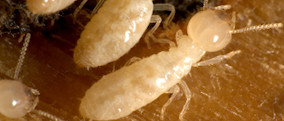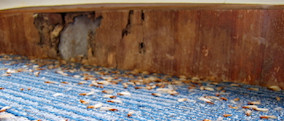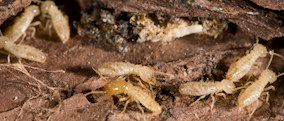


Subterranean termites are the most common and economically important wood-destroying organisms in Australia. Termites feed on materials that contain cellulose, primarily dead wood and wood by-products.
Subterranean termites are closely associated with the soil habitat where they excavate a network of tunnels through the soil to reach water and food. These termites need moisture to survive.
Biology
Subterranean termites are social insects that live in colonies that may contain hundreds of thousands of individuals. Termite colony members are dispersed throughout the soil and can extend underground tunnels to hundreds of meters to reach feeding sites.
Each termite colony contains three forms or castes, which are the workers, soldiers, and reproductives. These castes are physically distinct and perform different tasks in the termite society.
Workers are about 5 mm long and are blind, wingless, soft-bodied, creamy white to grayish-white with a round head. Workers are the most numerous individuals in a termite colony, and they are the termite caste that actually eats the wood. These sterile individuals forage for food and water, construct and repair shelter tubes, feed and groom other termites, care for eggs and young, and participate in colony defense.
Soldiers are also wingless and resemble workers except that they have a large, rectangular, yellowish-brown head with large mandibles (jaws). The soldiers’ primary function is colony defense.
Male and female reproductives can be winged (primary) or wingless (neotenic). Each can produce new offspring. Winged primary reproductives are called alates. However, they shed their wings soon after flight. Their body color varies by species from black to yellow-brown. A pair of primary reproductives that heads a colony is called the king and queen. Neotenic reproductives often serve as replacements if something happens to the king and queen.
Detection of Termites
It is important for homeowners to recognize the signs of a subterranean termite infestation. Subterranean termites may be detected by the sudden emergence of winged termites (alates), or by the presence of mud tubes and wood damage.
Winged Termites
Large numbers of winged termites swarming from wood or the soil often are the first obvious sign of a nearby termite colony. Swarming occurs in mature colonies that typically contain at least several thousand termites. A "swarm" is a group of adult male and female reproductives that leave their colony in an attempt to pair and initiate new colonies.
Alate emergence is stimulated when temperature and moisture conditions are favorable, usually on warm days following rainfall. In Melbourne, swarming typically occurs during dusk in the spring (October/November), but swarms can occur indoors during other months. However, swarming occurs during a brief period (typically less than an hour), and alates quickly shed their wings. Winged termites are attracted to light, and their shed wings in window sills, cobwebs, or on other surfaces often may be the only evidence that a swarm occurred indoors. The presence of winged termites or their shed wings inside a home should be a warning of a termite infestation.
Termite alates have straight, bead-like antennae; a thick waist; and two pair of long, equal-length wings that break off easily. Winged termites can be differentiated from winged ants, which have elbowed antennae, a constricted waist, and two pair of unequal-length wings (forewings are larger than hind wings) that are not easily detached. Ants also generally are harder-bodied than termites.
Mud Tubes
Other signs of termite presence include mud tubes and mud protruding from cracks between boards and beams. Subterranean termites transport soil and water above ground to construct earthen runways (shelter tubes) that allow them to tunnel across exposed areas to reach wood. Shelter tubes protect them from the drying effects of air and from natural enemies, such as ants. These tubes usually are about 1 cm to 3 cm wide, and termites use them as passageways between the soil and wood.
Wood Damage
Termite damage to the wood’s surface often is not evident because termites excavate galleries within materials as they feed. Wood attacked by subterranean termites generally has a honeycombed appearance because termites feed along the grain on the softer spring growth wood. Their excavations in wood often are packed with soil, and fecal spotting is evident. Severely damaged wood may have a hollow sound when it is tapped. Subterranean termites do not reduce wood to a powdery mass, and they do not create wood particles or pellets, as do many other wood-boring insects.
Prevention
Preventive practices are a critical aspect of termite management. Prevention of subterranean termite infestation of wooden structures centers upon disrupting their ability to locate moisture, food (wood), and shelter.
Avoid moisture accumulation near the foundations, which provides water needed for termite survival. Divert water away from the foundations with properly functioning down pipes and gutters. Soil needs to be graded or sloped away from the foundation in order for surface water to drain away from the building.
Cellulose (wood, mulch, paper, etc.) that is in contact with soil provides termites with ready and unobservable access to food. It is very important to eliminate any contact between the wooden parts of the house foundations and the soil. Never stack or store firewood, timber,
newspapers, or other wood products against the foundation or within the sub floor. Before and during construction, never bury wood scraps or waste timber in the backfill, especially near the building. Be sure to remove wooden form boards, grade stakes, etc. used during construction. Remove old tree stumps and roots around and beneath the building. Avoid or minimize use of wood mulch next to the foundations.
Control Measures
Termites feed slowly so there is no need to panic if they are discovered in one’s home. A few weeks may be needed to decide on a course of treatment, which typically requires employing a professional pest management firm. Homeowners seldom have the experience, availability of pesticides, and equipment needed to perform the job effectively. Consider getting at least three quotes before signing a contract for control measures, and be cautious of price quotes that are substantially lower or higher than the others. Prices for inspection, treatment estimates, and conditions of warranties often vary considerably. A guarantee is no better than the firm who presents it. It is important to take your time to select a reputable pest management firm. Deal only with licensed, certified pest management firms having an established place of business and a good professional reputation. Ideally the firm will belong to a national pest management association.
Soil Barrier Termiticides
Conventional soil treatments rely on creating a chemical barrier in the soil that is toxic to termites contacting it. Many also have repellent
characteristics and termites avoid treated soil. To achieve termite control for long periods of time, such termiticides must be applied as a continuous barrier in the soil next to and under the foundations. If there are untreated gaps in the soil, termites may circumvent the chemical treatment. Hence, such treatments during pre-construction can provide for more uniform coverage. Once a home is constructed, the chemical has to be injected through drill holes and trenching around the foundations, which can result in less accurate coverage. Effective termite control usually requires specialized equipment and often 400 or more liters of prepared termiticide solution per house, depending on size. Termiticides that act by creating a chemical barrier in the soil include bifenthrin (BiFlex®). In reference to "spot treatments only" using chemical barrier termiticides only in areas of the house where termites are seen, most pest management firms will refuse such treatments or will not guarantee such treatments. The reason is that termites have a very high probability of finding other
untreated points of entry into the structure. Localized spot treatments are considered risky except in re-treatment situations.
Treated-Zone Termiticides
The most recent termiticides to be marketed are non-repellent to termites, but show delayed toxicity as termites forage through treated soil, which they do not avoid. As termites penetrate the "treated zone," they contact the active ingredient, which causes delayed mortality and also possibly allows the termites to be overcome by lethal microbes. Furthermore, the toxicant is thought to be passed to nestmates through grooming activities and social food exchange (trophallaxis). Control usually is achieved within 3 months. As with soil barrier termiticides, specialized application equipment and large volumes of chemical solution are needed. Non-repellent termiticides include imidacloprid (Premise®).
Baits
Termite Baits. Bait technology uses wood or a cellulose matrix favored by termites that is impregnated with a slow-acting toxic chemical. Termite workers feed upon the bait and transfer it by grooming or trophallaxis to other colony members, eventually reducing or eliminating the entire colony. Termites are not site-specific, but rather, they forage among various food sites, which results in the bait being encountered by many colony members. The toxicant necessarily is slow acting because termites tend to avoid sites where sick and dead termites accumulate.
Typically, in-ground stations are inserted in the soil next to the structure and near known or suspected sites of termite activity. In-ground stations often initially contain untreated wood that serves as a monitoring device. The monitoring wood is replaced with the toxicant once termites have been detected feeding on it. In addition, aboveground stations may be installed inside or on the structure in the vicinity of damaged wood and shelter tubes. Aboveground stations initially contain bait.
It is very important that bait systems are properly installed and diligently serviced. Monthly inspections of a baiting system usually are necessary, except during inclement winter weather. Successful termite baiting necessitates proper monitoring and maintenance of the stations.
Baits work much more slowly than soil termiticides, and the homeowner should be aware of the possibility of a lengthy baiting process. Several months or more may elapse before the termites locate stations, then termites must feed on sufficient amounts of the toxicant.
An often-cited advantage of termite baits is that they are "environmentallyfriendly" because they use very small quantities of chemical and decrease the potential for environmental contamination. In addition, bait application causes little disruptive noise and disturbance compared to soil treatments. Baits are often used in sensitive environments.
Bait products include the Exterra® Termite Interception and Baiting System. Not all of these bait systems are equally effective. It is advisable to review the independent research that has been conducted on a particular bait, as some products have been evaluated much more rigorously than others.
Physical Barriers
Physical barriers are particularly appropriate during the pre-construction phase to provide protection of the structure from subterranean termites. Physical barriers include (Homeguard®) termiticide in bedded plastic building products in the form of penetration collars, moisture membrane and damp proof corse, that is fitted around pipes, to the under slab area, or brick work.

